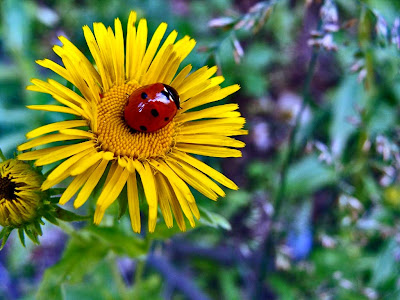 Coccinella septempunctata
Coccinella septempunctataIn parts of Northern Europe, tradition says that a persons wish is granted if a ladybird lands on them (this tradition lives on in North America, where children capture a ladybug, make a wish, and then "blow it away" back home to make the wish come true). In Italy, it is said by some that if a ladybird flies into a bedroom, it is considered good luck. Incentral Europe, a ladybird crawling across a girl's hand is thought to mean she will get married within the year. In some cultures they are referred to as fortune bugs.
In Russia, a popular children's rhyme exists with a call to fly to the sky and bring back bread; similarly, in Denmark a ladybird, called a mariehøne ("Mary's hen"), is asked by children to fly to 'our lord in heaven and ask for fairer weather in the morning'.
The name that the insect bears in the various languages of Europe is mythic. In this, as in other cases, the Virgin Mary has supplanted Frejya, the fertility goddess of Norse mythology; so that freyjuhœna and Frouehenge have been changed into marihøne and Marienvoglein which corresponds with Lady Bird; similarly, in Serbian the common name is bubamara (buba-Mara, Mary-beetle). In Spanish its most common name is mariquita, also a reference to the Virgin Mary. The esteem with which these insects are regarded has roots in ancient beliefs.
In Irish, the insect is called bóín Dé — or "God's little cow" and in Welsh, the term buwch goch gota is used, containing the word 'buwch' meaning "cow"; similarly, in Croatian it is called Božja ovčica ("God's little sheep") and in Romanian gărgăriţă, buburuză, vaca-Domnului ("Lord's cow"), boul Domnului ("Lord's oxen") or găina lui Dumnezeu ("God's hen"). Moreover, in Romanian it is also called mărie, măriuţă or mămăruţă, terms derived from the personal name Mary (cf. the Norwegian, German and Serbian names for the ladybug).
In France it is known as bête à bon Dieu, "the Good Lord's animal", and in Rusia, Божья коровка ("God's little cow").
In Iran, two Persian words are used; ﮐﻔﺶ ﺪوزک and ﭘﻴﻨﻪ ﺪﻮﺰ, both meaning "shoe cobbler".
In greece, ladybirds are called πασχαλίτσα (paschalitsa), because they are found abundantly in eastertime, along with paschalia, the Common Lilac plant, which flowers at the same time.
In Turkey, ladybirds are called uğur böceği, literally meaning luck bug. When a ladybird lands on children, they wish something and sing Uç uç böceğim, annen sana terlik pabuç alacak (Fly fly my bug, your mother will buy you slippers and shoes).
In Finnish, ladybird is, for its blood red color, called leppäkerttu, translating to Blood Gertrud from the ancient Baltic-Finnic meaning blood or the word leppä (that means alder in modern Finnish). An alternative name is leppäpirkko.WIKIPEDIA, OF COURSE.
5 comments:
Beautiful photo.
Interesting informations....
Les coccinelles sont très actives dans les jardins, elles mangent les pucerons ....et en plus elles sont belles !
Il y en a beaucoup par chez nous...
excelent...
I didn't know that, very interesting, I also didn't know they bit until one bit me. My daughter loved them and we let them walk on our hands then one day, I got bit.
And in China?:)
In gradina mea gasesti din ce in ce mai putine gargarite ca cea din poza... in schimb au aparut un soi de gargarite mai oranj, cu mai multe puncte decat cele obisnuite... cica importate din China de catre floristi si instalate confortabil in natura... te strânge in spate, drept sa-ti spun...
Post a Comment